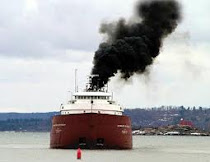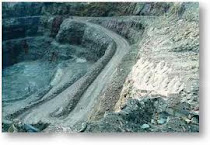Air Pollution Effects: Sulfur Dioxide
Sulfur dioxide (SO2) is a colorless gas with a pungent, suffocating odor. SO2 is corrosive to organic materials and it irritates the eyes, nose and lungs; therefore it is quite a dangerous air pollutant. (4)
Sulfur is contained within all fossil fuels, and is released in the form of sulfur dioxide during fossil fuel combustion.
Because of the widespread use of fossil fuels, sulfur dioxide is among the most common air pollutants produced in every part of the planet.
Sulfur dioxide may often act in synergy with other pollutants (ex., airborne particles) to produce certain air pollution effects.
Let’s summarize some sulfur dioxide pollution effects on human health (5, 6, 7):
- Irritation of eyes, nose, throat; damage to lungs when inhaled
- Acute and chronic asthma
- Bronchitis and emphysema (as a result of synergy between SO2 and suspended particulate matter)
- Lung cancer
Air Pollution Effects: Nitrogen Dioxide
Nitrogen dioxide (NO2) is a gas of reddish-brown color with a distinct sharp, biting odor. It is often analyzed in conjunction with another nitrogen gas – nitric oxide (NO). Together these two gases are referred to as NOx.
Combustion of fossil fuels always produces both NO2 and NO.
But almost 90% of the NOX combustion product is in the form of NO which is then oxidized to NO2 in the air. (12, 13)
NOx can destroy organic matter, ex. human tissue. Exposure to high concentrations of NOx can make living organisms more susceptible to bacterial infections and lung cancer. (14)
Just like other pollutants, nitrogen dioxide affects people with existing medical conditions more severely than healthy people.
For example, asthma sufferers may experience enhanced sensitivity after short-term NO2 exposure as compared to those without any asthmatic problems. (15)
Another group at higher risk is children. For instance, children aged 12 and younger who are exposed to NOx suffer more respiratory illness than the ones who are not exposed. (16)
Depending on different NO2 concentrations in the air, nitrogen dioxide pollution effects may be as follows (17, 18):
- Increased incidence of respiratory illness
- Increased airway resistance (due to inflammation)
- Damage to lung tissue
- Chronic obstructive pulmonary disease, or COPD (narrowing of the airways)
- Emphysema (as part of COPD)
- Pulmonary edema (accumulation of excessive fluid in the lungs)
- Infant and cardiovascular death
It is important to note that nitrogen dioxide is a major component of
the photochemical smogand thus a contributor to the formation of ozone which is another serious air pollutant. See more about
effects of ozone here.
Air Pollution Effects: Carbon Monoxide
Carbon monoxide (CO) is an extremely toxic gas which affects the ability of the body to receive oxygen. Hemoglobin which transports oxygen in the blood is bound by carbon monoxide, which leads to the shortage of oxygen in the body. (19)
Carbon monoxide is the most common type of fatal poisoning in many countries around the world. (20)
Unlike many other air pollutants, carbon monoxide does not directly affect eyes, nasal passages or lungs. (21)
Exposure to carbon monoxide may lead to (22, 23, 24):
- Toxicity of the central nervous system and heart
- Headaches, dizziness, nausea and unconsciousness
- Loss of vision
- Decreased muscular coordination
- Abdominal pain
- Severe effects on the baby of a pregnant woman
- Impaired performance on simple psychological tests and arithmetic; loss of judgment of time
- In cases of prolonged exposure to high CO concentrations, unconsciousness, convulsions and death would occur
Carbon monoxide pollution effects are exacerbated in weaker people, specifically in those with heart and lung diseases. (25)
What makes this gas even more dangerous is the fact that it is invisible and odorless, and thus not immediately detectable as a hazard.
Air Pollution Effects: Ozone Effects
Ozone (O3) is a poisonous gas with a sharp and cold odor.
It can be found in the stratosphere where it occurs naturally and plays a beneficial role by protecting the Earth from ultraviolet sunlight; and in the troposphere where it occurs naturallyand also forms part of the human-caused photochemical smog.
It is of course the tropospheric ozone that we are interested in as an important air pollutant.
The chemical reaction between nitrogen oxides and volatile organic compounds (VOCs) in the presence of sunlight results in the photochemical smog; the tropospheric ozone is an end product of this reaction and a component of the smog itself.
Because the photochemical smog requires a lot of sunshine to form, it occurs mostly in sunny and heavily polluted places, such as Los Angeles, Mexico City and even Athens.
Ozone’s main “victim” within the human body is its respiratory system.
Once in the lungs, ozone burns through cell walls. The immune system fails to protect the lungs because ozone pushes the defensive cells back. As cellular fluid starts seeping into the lungs, breathing becomes rapid, shallow and painful. (26)
Exposure to ozone over long periods of time leads to a stiffening of the lungs and a reduced ability to breathe. (27)
As an example, a study conducted in California in the 1980s shows that children living in ozone-polluted areas have smaller than normal lungs and adults lose up to 75% of their lung capacity. (28)
So, exposure to the tropospheric ozone may cause (29, 30, 31):
- Burning nose and watering eyes
- Tightening of the chest
- Coughing, wheezing and throat irritation
- Rapid, shallow, painful breathing
- Susceptibility to respiratory infections
- Inflammation and damage to the lining of the lungs
- Aggravation of asthma
- Fatigue
- Cancer
Air Pollution Effects: Ammonia Effects
Ammonia is a colorless, pungent, hazardous caustic gas composed of nitrogen and hydrogen.
Though ammonia is used for different applications in many sectors, agriculture is its largest consumer and producer.
Livestock farming, animal waste and fertilizer application are the biggest sources of atmospheric ammonia emissions within the agricultural sector.
Gaseous ammonia is a dangerous air pollutant. Breathing in large amounts can cause death. (32)
So, ammonia pollution effects are (33, 34, 35):
On the respiratory system :
 Ammonia Fertilization
Ammonia Fertilization
Australia, c. 1975
Photo:
Rae Allen- Nose & throat irritation and burns (their severity increasing with the increased ammonia concentrations)
- Swelling of the throat and airways; airways destruction
- Pulmonary edema
- Chronic lung disease
- Cough
- Asthma
- Lung fibrosis
- Inhaling large amounts of ammonia can be fatal
On the skin & eyes :
- Skin burns
- Skin conditions, ex. dermatitis
- Burning sensation in the eyes
- Ulceration & perforation of the cornea (can occur months after exposure); blindness
- Cataracts & glaucoma
Air Pollution Effects: Volatile Organic Compounds
Volatile organic compounds (VOCs) are defined as organic compounds which easily evaporate and enter the atmosphere.
VOCs are important pollutants for two reasons.
First , they are precursors to the formation of ozone (which is part of the photochemical smog); second, they include compounds which are carcinogenic and mutagenic in their own right. (37)
 Oil is a source of VOCs
Oil is a source of VOCs
Photo:
Jay-PTypical VOCs include propane, benzene, ethanol, methanol, ether, carbon tetrachloride and vinyl chloride; substances such as petrol and resins contain many individual VOCs, and many others are produced during combustion processes. (38)
Toxicity of some VOCs and ensuing health effects are no doubt issues of serious concern.
For example, exposure to benzene and 1,3-butadieneis a suspected cause of around 10% of leukemia incidence in the UK. (39)
Exposure to toluene – another dangerous VOC – may lead to the dysfunction of the central nervous system resulting in behavioral problems, memory loss and disturbance of the circadian rhythm (40); toluene is also suspected to cause cancer (41).
Some other VOCs, ex. carbon tetrachloride and PCBs, are believed to produce abnormal changes in fetus development (42) and consequently lead to birth defects. Carbon tetrachloride also leads to liver damage (43).
Vinyl chloride causes Raynaud's phenomenon (spasms in the small arteries that cause the extremities to become pale and cold, as well as painful), necrosis of the small bones of the hand, liver damage, and a rare, highly malignant tumor of the liver. (44)
Benzene pollution effects on human health (45):
- Short-term breathing of low levels of benzene can cause drowsiness, dizziness, rapid heart rate, headaches, tremors, confusion and unconsciousness; exposure to high levels of benzene may result in death
- Chronic effects:
- Damage to the bone marrow
- Decrease in red blood cells (anemia)
- Excessive bleeding and depression of the immune system increasing the risk of infection
- Leukemia
1,3-Butadiene pollution effects on human health (46):
- Short-term exposure to high levels of 1,3-butadiene may lead to distorted blurred vision, vertigo, general tiredness, decreased blood pressure, headache, nausea, decreased pulse rate, and fainting
- Long-term exposure to high levels can increase the risk of cardiovascular diseases and cancer
Let us summarize some effects of VOCs on human health:
- Tiredness, vertigo, drowsiness, dizziness, nausea, confusion, unconsciousness
 Tiredness
Tiredness - Anemia
- Bone marrow damage
- Liver damage
- Dysfunction of the central nervous system:
- Behavioral problems
- Memory loss
- Disturbance of the circadian rhythm
- Cardiovascular diseases
- Cancer; specifically leukemia
- Abnormal changes in fetus development, birth defects
- VOCs also contribute to sick building syndrome indoors
- As facilitators in ozone formation, VOCs may indirectly contribute to respiratory problems
Air Pollution Effects: Airborne Particles
Airborne particles are tiny fragments of solid or liquid nature suspended in the air (which are called aerosols).
Particles may be primary – when emitted into the atmosphere directly by sources, or secondary– when formed in the atmosphere through the interaction of primary pollutants.
For example, sulfur oxides and nitrogen oxides are primary pollutants which may transform in the air into sulfates and nitrates. (47)
Dust particles are solid particles between 1 and 100 μm (micrometres) in diameter; fumes, or smoke, are solid particles less than 1 μm in diameter.
Experts believe that dust is the most damaging among all widely measured air pollutants. (48)
Smaller dust particles are more dangerous than larger ones because they can penetrate deep into the lungs being deposited on areas where the body’s natural clearance mechanisms such as coughing cannot remove them. (49)
Combustion of fossil fuels by road transport, power plants etc. is a major source of particulate air pollution.
Particles may come in a whole variety of chemical compositions including heavy metals such as cadmium, mercury and lead. (50)
They often act in synergy with other air pollutants, ex. sulfur dioxide, to produce negative health effects in humans.
As particulate pollution levels rise, it is common to see an increase in hospital admissions for (51):
- Stuffy noses, sinusitis
- Sore throats
- Wet cough, dry cough, phlegm
- Head colds
- Burning eyes
- Wheezing; shortness of breath
- Lung disease
- Chest discomfort or pain
As with other pollutants, children are of course more susceptible to particulate pollution.
Specific children’s disorders caused by airborne particles may include (52, 53, 54):
- Infant death
- Low birth weight
- Reduced lung function
 Protection from Pollution
Protection from Pollution
Los Angeles
Photo:
Dave BlumeHere is a summary of the particulate pollution effects provided by the US Environmental Protection Agency (55):
- Increased respiratory symptoms (ex. irritation of the airways, coughing, difficulty breathing)
- Decreased lung function
- Aggravated asthma
- Chronic bronchitis
- Irregular heartbeat
- Nonfatal heart attacks
- Premature death in people with heart or lung disease
Indeed, particulate pollution affects both developed and developing countries:
- For example, a major study conducted in the US between 1982 and 1989 found that people living in American cities with the highest levels of particulate air pollution were 15% to 17% more likely to die one to three years early (56)
- In another example, particulate air pollution is linked to nearly 350,000 premature deaths in China and India every year (57)
Leia Mais…


 Trees Damaged by Sulfur Emissions
Czech Republic
Photo:
Trees Damaged by Sulfur Emissions
Czech Republic
Photo: 






 Tiredness
Tiredness 







